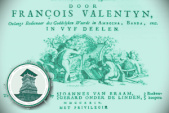I.6 Religions, Scriptures, Languages and Books

The first allies of the VOC were Muslim rulers who were on a hostile footing with the Portuguese. Prominent here were the raja of Hitu, the sultan of Ternate and the rulers of Johor. Early baptismal registers from former Portuguese establisments such as Labuha (on the island of Bacan in Maluku) show how people with Catholic names were mixed up with those with Dutch Protestant names. Inter-religious relations between Muslims and Christians in VOC-controlled territories were often stable and peaceful. The VOC followed a strict policy of ‘cuius regio, eius religio’: ‘whose realm, his religion’. Protestant church ministers were forbiddenfrom initiating missionary activities in the territory of a Muslim ruler until well into the nineteenth century.
Both communities lived side by side peacefully and not only in VOC-controlled towns like Batavia, Ambon, and Makassar. One eighteenth-century Banten sultan once attended a church service just out of personal curiosity. Trading towns like Banten could also be important arenas for religious exchange and dialogue. The Dutch Bible translator, the Rev. Melchior Leydekker (1645-1701), collected Arab-Malay manuscripts in Banten in the 1690s to learn about how Islamic theological concepts and idioms were used. This certainly influenced the classic form of Malay which Leydekker and others adapted for the first Bible translation into Malay in 1733 - the Leydekker-Werndly translation was published in Arabic script in 1758.
Religious activities from both monotheist religions stimulated the spread of Arabic and Malay during the seventeenth and eighteenth centuries. Subsequently, the spread of Islam and Christianity, in particular in Eastern Indonesia, also influenced the establishment of schools and the spread of books and literacy.




